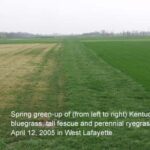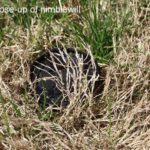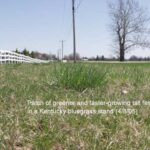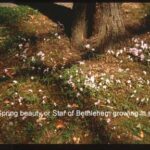Zac Reicher

Quicksilver Receives 24C Registration for Moss on Greens in Indiana
FMC’s QuickSilver T&O herbicide has just received special local 24(c) registration for control of silvery thread moss in putting greens in Indiana. Though Quicksilver (carfentrazone) is used widely as a quick knockdown contact broadleaf herbicide, it has good efficacy on silvery thread moss. The recommended rate for moss is 6.7 fluid oz/A (0.154 oz/1000 ft2 followed […]
Midwest Regional Turf Field Day on July 26
Gear up for the Midwest Regional Turf Field Day that will be held on July 26 at the W.H. Daniel Turfgrass Research and Diagnostic Center in West Lafayette. This is a great opportunity for turf professionals to view the latest in turfgrass research, talk to Purdue specialists about turf and ornamental issues, and visit with […]
Early Dollar Spot Applications Make Sense
Dollar spot has arrived on golf courses. The standard mid- to late May fertilization of 0.75-1.0 lb N/1000 sq. ft. with primarily slow release N should have helped minimize some dollar spot. On golf courses with a long history of dollar spot, first and foremost review the fertilization practices and increase the annual N if […]
Maximizing Lawn Performance Under Drought
As low moisture conditions continue in Indiana and Indianapolis is already requesting volunteer reductions in water use, it is time to start preparing for a potentially serious drought. Generally, turf can survive 5 to 8 weeks of dry conditions without substantial thinning or death. However, poor soils, traffic, excess heat, low mowing and/or scalping, and […]
Fertilizing Sports Turf
Fertilizing sports turf is critical in order to maintain turf vigor in spite of intense wear and tear. However, too little fertilizer or poorly timed fertilizer are common mistakes on sports complexes. Following are our recommendations for sports field fertilization: Apply fertilizer just prior to the season to insure aggressive growth Apply60% or […]
Fundraiser Golf Tournament for Don LaPierre
A good friend of the Indiana turf industry, Don LaPierre, has recently been diagnosed with cancer. A fundraiser golf tournament for Don and his family will be held on June 21st at Greenfield Country Club in Greenfield, followed by a live auction. One hundred percent of the proceeds will go to Don and his family. […]
Phosphorus Fertilization in Turf
Phosphorus (P) fertilization of turf is being questioned nationally for two reasons. Phosphorus fertilization almost never induces a visual turfgrass response and deficiency symptoms are rarely seen, thus calling into question the need for P fertilization. Secondly, higher levels of P contribute to algal blooms and decrease water quality of ponds, lakes, and streams. Since […]
Late May is Good Time to Fertilize Lawns
The annual phase of rapid cool-season shoot growth of cool-season grasses is nearly complete, though it was diminished this year because of the dry and cool weather. It’s now time to consider fertilizing your lawn because fertilizer now will not dramatically increase vertical growth as long as moderate nitrogen rates are used and it will […]
Annual bluegrass (Poa annua) in Full Bloom in Lawns and Athletic Fields
Annual bluegrass is now very common in lawns and athletic fields, though it has been a problem on golf courses for years. Annual bluegrass is a lighter green than Kentucky bluegrass and perennial ryegrass, and will thin and die during the heat and drought of August in Indiana. It’s especially noticeable now because of it’s […]
Don’t Trust the Tonics You Hear on TV
There’s a number of “tonics” recently extolled on local and national television that include ingredients like shampoo, ammonia, cola (not diet of course), beer (not light beer), hydrogen peroxide, and dish soap among others. Though you may think you see some effect of these products, there is little or no scientific basis for applying these […]
Time is Running Out for Preemergence Control of Crabgrass
The below average temperatures the last few days has delayed crabgrass germination and thus premergence annual grass herbicides should still be effective if applied this week in the northern half to 2/3rds of the state. Most of the preemergence herbicides do have some post-emergence properties that will burn back small crabgrass (one or two leaf […]
Watch for Breakthrough from Early Preemergence Herbicide Applications
The extremely dry spring may reduce the effectiveness of preemergence herbicides. The products must be watered-in or rained-in to move them below the canopy and down to the soil where they will be effective. Herbicides not watered-in may also photodegrade faster than those wateredin. Early research showed a 44% loss in three days of preemergence […]
Slowly Greening Lawns
Many lawns are slow to green-up this year and it is mostly due to the presence of Kentucky bluegrass. Even though Kentucky bluegrass is the best lawn grass for the Midwest, it is much slower than perennial ryegrass and tall fescue to green up in the spring (photo). A little patience, some rain, and some […]
Spring Dandelion Control for Professionals
Many turf areas did not get treated for broadleaf weeds last fall because of the dry weather. Though fall applications are most effective for controlling broadleaf weeds, spring applications are warranted for new lawns or areas that did not get treated last fall. Spring applications will be most effective if you wait until dandelions are […]
Tan Patches in an Otherwise Green Lawn
Tan patches in an otherwise green lawn at this time of the year are likely due to either slow-greening warm-season grasses or snow mold. The most common tan patch right now is warm-season grasses like nimblewill or zoysia (photos). Time, warming temperatures, and rainfall are the cures for most of these patches and they should […]
Dark Green Patches in Otherwise Lighter Green Lawn
Patches of tall fescue or perennial ryegrass are currently much greener than Kentucky bluegrass (photos). Patches of these two grasses are prominent right now as the bluegrass is just starting to green up. Give it another week and the bluegrass will catch up with the tall fescue or ryegrass. No control is needed to remove […]
Star of Bethlehem, Spring Beauty Emerging in Shaded Areas
Star of Bethlehem and Spring Beauty are currently emerging and flowering in shaded areas. Both plants have pretty white flowers with the Star of Bethlehem having six petals while Spring Beauty has only five petals . The Star of Bethlehem was once planted as an ornamental while the Spring Beauty is native. Both plants are […]
Dandelions: Friend or Foe?
The annual bloom of dandelions is already here in southern Indiana and just around the corner in the rest of the state. Though some find dandelions attractive and some may actually eat them in salads or wine, others consider dandelions as weeds and try to control them in a lawn. The optimum time to control […]
Herbicide Delays after Seeding
Almost all herbicides will affect turfgrass seedlings and application delays are usually needed following seeding. Following is information gleaned from available labels of most herbicides or herbicide types that would be used in Indiana . This is intended to provide a general idea of the limitations of each active ingredient, but please refer to the […]




